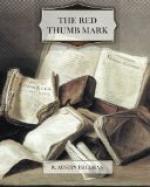“Have you given any attention to the subject of finger-prints?”
“Yes. A great deal of attention.”
“Be good enough to examine that paper” (here the usher handed to Thorndyke the memorandum slip). “Have you seen it before?”
“Yes. I saw it at Scotland Yard.”
“Did you examine it thoroughly?”
“Very thoroughly. The police officials gave me every facility and, with their permission, I took several photographs of it.”
“There is a mark on that paper resembling the print of a human thumb?”
“There is.”
“You have heard two expert witnesses swear that that mark was made by the left thumb of the prisoner, Reuben Hornby?”
“I have.”
“Do you agree to that statement?”
“I do not.”
“In your opinion, was the mark upon that paper made by the thumb of the prisoner?”
“No. I am convinced that it was not made by the thumb of Reuben Hornby.”
“Do you think that it was made by the thumb of some other person?”
“No. I am of opinion that it was not made by a human thumb at all.”
At this statement the judge paused for a moment, pen in hand, and stared at Thorndyke with his mouth slightly open, while the two experts looked at one another with raised eyebrows.
“By what means do you consider that the mark was produced?”
“By means of a stamp, either of indiarubber or, more probably, of chromicized gelatine.”
Here Polton, who had been, by degrees, rising to an erect posture, smote his thigh a resounding thwack and chuckled aloud, a proceeding that caused all eyes, including those of the judge, to be turned on him.
“If that noise is repeated,” said the judge, with a stony stare at the horrified offender—who had shrunk into the very smallest space that I have ever seen a human being occupy—“I shall cause the person who made it to be removed from the court.”
“I understand, then,” pursued Anstey, “that you consider the thumb-print, which has been sworn to as the prisoner’s, to be a forgery?”
“Yes. It is a forgery.”
“But is it possible to forge a thumb-print or a finger-print?”
“It is not only possible, but quite easy to do.”
“As easy as to forge a signature, for instance?” “Much more so, and infinitely more secure. A signature, being written with a pen, requires that the forgery should also be written with a pen, a process demanding very special skill and, after all, never resulting in an absolute facsimile. But a finger-print is a stamped impression—the finger-tip being the stamp; and it is only necessary to obtain a stamp identical in character with the finger-tip, in order to produce an impression which is an absolute facsimile, in every respect, of the original, and totally indistinguishable from it.”
“Would there be no means at all of detecting the difference between a forged finger-print and the genuine original?”




